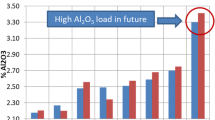Abstract
The differences in performance between low- and high-purity grades of briquetted SiC need to be better understood for achieving maximum benefits, as both are very complicated materials that perform quite differently with advantages and disadvantages relative to each other. The effect of the degree of SiC purity on melt yield has not heretofore been accurately quantified by comprehensive mass balances for all inputs and outputs, so melt yield as a function of SiC purity is an important stand-alone metric which also serves to standardize all other variables by which all other effects (performance metrics) can be accurately quantified. The complexity of the interactions between all cupola melt process variables and the resultant effects makes it very difficult to obtain meaningful measurements by which satisfactory performance assessments can be made in comparing the relative values of low- and high-purity SiC. However, this project utilized comprehensive metal, slag and stack gas analyses which were needed for comprehensive mass balances in correlating all material inputs and outputs. The results of that were the basis for accurate assessments of performance metrics in comparing the relative advantages and disadvantages of each purity grade of SiC briquettes.












Similar content being viewed by others
Change history
03 April 2022
The corresponding author's email has been added.
References
42nd Census of World Casting Production-2007. Engineered Casting Solutions (Jan/ Feb 2009)
S. Katz, M. Bauer, T. Mutton, Performance of briquetted and lump silicon carbide in cupola operations. AFS Trans. 112, 1021–1036 (2004)
Slag Atlas. Verlag Stahleisen MBH, Dusseldorf, Germany, p. 39 (1981)
R. C. Creese, Cupola Handbook. Chapter 12–Combustion, 6th edition, American Foundry Society (1999)
R. C. Creese, Cupola Handbook. Chapter 13–Thermochemistry, 6th edition, American Foundry Society (1999)
D. Saha, D. Donner, Cupola Handbook. Chapter 14–Blast Conditioning, 6th edition, American Foundry Society (1999)
D. R. Gaskell, Introduction to Thermodynamics of Materials. 3rd edition, Taylor and Francis, p. 370 (1995)
D. C. Williams, Reviewing Grey and Ductile Iron Slags in Melting, Holding and Pouring Applications. AFS International Ferrous Melting Conference, Nashville, TN, USA, slides 7 and 9 (Oct. 2012)
J. Ekengard, A. Dioszegi, Oxygen Activity and Slag Formation in Cast Irons. The Carl Loper Cast Iron Symposium, Madison, WI, USA (May 2009)
O. Angeles, G.H. Geiger, C.R. Loper Jr., Factors Influencing Carbon Pickup in Cast Iron. AFS Trans. 76, 629–637 (1968)
R.G. Olsson, V. Koump, T.F. Perzak, Rate of Dissolution of Carbon in Fe-C Alloys. Trans. AIME 236, 426–429 (1965)
S. Katz, Cupola Handbook. Chapter 8–Fuels, 6th edition, American Foundry Society (1999)
C. C. Wright, Anthracite as Cupola Fuel. American Foundryman, pp. 40–47 (Nov. 1947); pp. 34–37 (Dec. 1947)
W. Patterson, H. Siemen, H. Pacyna, Die Tofitian and Armenia des Kaltwindkupolafens. Giesserei-Technish-Wissenschafliche Beihefte, pp. 239–238 (Oct. 1961), and pp. 1–20 (Jan. 1962)
H. A. Fine, G. H. Geiger, Handbook on Material and Energy Balance Calculations in Metallurgical Processes. 2nd edition, The Minerals, Metals, and Materials Society (TMS) (1993)
J. F. Elliott, M. Gleiser, Thermochemistry for Steelmaking. vol. 1, Addison-Wesley (1960)
J. P. Coughlin, Heats and Free Energies of Formation of Inorganic Oxides. U.S. Govt. Print. Office (1954)
Handbook of Chemistry and Physics. 75th edition, CRC Press, Section 5: “Thermochemistry, Electrochemistry, and Kinetics,” (1994–1995)
A.W. Buchcuski, B.W. Buchcuski, G.S. Jarski, J.W. Cree, Effects of Varying SiC Purity on Cupola Melt Performance. AFS Trans. 125, 199–213 (2017)
Acknowledgements
The authors acknowledge the support of Sy Katz & Associates, West Bloomfield, MI, and Bill LaFramboise, proprietor of Auburn Analytical Labs, Midland, MI. Thanks also to Mike Robles, Jr. and Adam Hoover of Grede – New Castle for their help in formatting the tables and figures used within this paper, and to Sue Thomas-Sadowski (AFS) for editing the AFS Transactions version of this paper.19
Author information
Authors and Affiliations
Corresponding author
Ethics declarations
The authors declare that they have no conflict of interest.
Additional information
Publisher's Note
Springer Nature remains neutral with regard to jurisdictional claims in published maps and institutional affiliations.
Rights and permissions
About this article
Cite this article
Cree, J.W., Buchcuski, A.W., Buchcuski, B.W. et al. Effects of Varying SiC Purity on Cupola Melt Performance. Inter Metalcast 17, 39–53 (2023). https://doi.org/10.1007/s40962-022-00775-z
Received:
Accepted:
Published:
Issue Date:
DOI: https://doi.org/10.1007/s40962-022-00775-z




